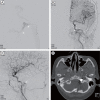Transvenous coil embolization of hypoglossal canal dural arteriovenous fistula using detachable coils: A case report
- PMID: 34696553
- PMCID: PMC9260460
- DOI: 10.7461/jcen.2021.E2021.08.004
Transvenous coil embolization of hypoglossal canal dural arteriovenous fistula using detachable coils: A case report
Abstract
The hypoglossal canal (HC) is an unusual location of the posterior fossa dural arteriovenous fistula (AVF), which usually occurs in the transverse or sigmoid sinus. Herein, we report a case of HC dural AVF successfully treated with transvenous coil embolization using detachable coils in a 68-year-old woman who presented with headache and left pulsatile tinnitus for 2 months. Brain magnetic resonance imaging (MRI) and cerebral angiography revealed left HC dural AVF. The pulsatile bruit disappeared immediately after the procedure. Follow-up MRI showed complete disappearance of the fistula. Precise localization of the fistula through careful consideration of the anatomy and transvenous coil embolization using a detachable coil can facilitate the treatment for HC dural AVF.
Keywords: Coil Embolization; Dural Arteriovenous Fistula; Hypoglossal canal.
Figures




Similar articles
-
Transvenous embolization with detachable coils for a hypoglossal canal dural arteriovenous fistula: illustrative case.J Neurosurg Case Lessons. 2024 Nov 18;8(21):CASE24606. doi: 10.3171/CASE24606. Print 2024 Nov 18. J Neurosurg Case Lessons. 2024. PMID: 39556806 Free PMC article.
-
Ocular symptoms associated with a dural arteriovenous fistula involving the hypoglossal canal: selective transvenous coil embolization. Case report.J Neurosurg. 2001 Apr;94(4):630-2. doi: 10.3171/jns.2001.94.4.0630. J Neurosurg. 2001. PMID: 11302665
-
A case of sigmoid sinus dural arteriovenous fistula after treated cavernous dural arteriovenous fistula.Interv Neuroradiol. 1998 Nov 30;4 Suppl 1:219-22. doi: 10.1177/15910199980040S145. Epub 2001 May 15. Interv Neuroradiol. 1998. PMID: 20673478
-
[Dural arteriovenous fistula of the transverse sigmoid sinus after transvenous embolization of the carotid cavernous fistula].No To Shinkei. 1999 Dec;51(12):1065-9. No To Shinkei. 1999. PMID: 10654304 Review. Japanese.
-
[Hypoglossal canal dural arteriovenous fistulas treated with transvenous embolization:report of two cases and literature review].Zhejiang Da Xue Xue Bao Yi Xue Ban. 2017 Jul 25;46(4):445-448. doi: 10.3785/j.issn.1008-9292.2017.08.16. Zhejiang Da Xue Xue Bao Yi Xue Ban. 2017. PMID: 29256236 Free PMC article. Review. Chinese.
Cited by
-
In Vitro Head-to-Head Comparison of Flow Reduction between Fibered and Non-Fibered Pushable Coils.Neurointervention. 2024 Mar;19(1):31-38. doi: 10.5469/neuroint.2024.00031. Epub 2024 Feb 20. Neurointervention. 2024. PMID: 38373422 Free PMC article.
-
Transvenous embolization with detachable coils for a hypoglossal canal dural arteriovenous fistula: illustrative case.J Neurosurg Case Lessons. 2024 Nov 18;8(21):CASE24606. doi: 10.3171/CASE24606. Print 2024 Nov 18. J Neurosurg Case Lessons. 2024. PMID: 39556806 Free PMC article.
References
-
- Choi JW, Kim BM, Kim DJ, Kim DI, Suh SH, Shin N-Y, et al. Hypoglossal canal dural arteriovenous fistula: incidence and the relationship between symptoms and drainage pattern. J Neurosurg. 2013 Oct;119(4):955–60. - PubMed
-
- Combarros O, Alvarez de Arcaya A, Berciano J. Isolated unilateral hypoglossal nerve palsy: nine cases. J Neurol. 1998 Feb;245(2):98–100. - PubMed

